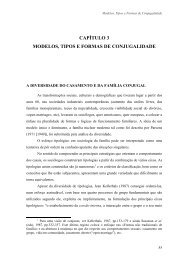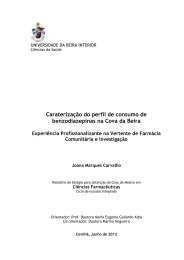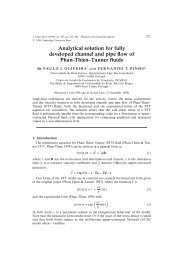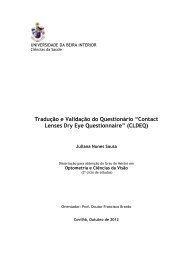Tese_Tânia Vieira.pdf - Ubi Thesis
Tese_Tânia Vieira.pdf - Ubi Thesis
Tese_Tânia Vieira.pdf - Ubi Thesis
You also want an ePaper? Increase the reach of your titles
YUMPU automatically turns print PDFs into web optimized ePapers that Google loves.
Chapter I - Introduction<br />
components or objects in the size range of 1–100 nm (Cumberland et al. 2009; Rai et al. 2009;<br />
Kurek et al. 2011).<br />
Bionanotechnology has emerged up as integration between biotechnology and<br />
nanotechnology, to allow the development of biosynthetic and environmental-friendly<br />
technology for synthesis of nanomaterials (Rai et al. 2009). Nanotechnology allowed the<br />
development of several materials, devices and systems (Öztürk et al. 2008; Türkmen et al.<br />
2009). Among the three areas mentioned above, the area of nanomaterials is the most advanced<br />
at present, both at the scientific level and for commercial applications (Öztürk et al. 2008;<br />
Cumberland et al. 2009; Türkmen et al. 2009). Nowadays nanomaterials are used for the<br />
development of novel devices that can be used in various physical applications as biophotonics,<br />
biosensors, fuel cells, photovoltaic devices, semiconductor nanowires, solar energy conversion,<br />
and also in catalysis, water treatment, and biological, biomedical and pharmaceutical<br />
applications (Raffi et al. 2008; Babu et al. 2010). Nanomaterials display unique and superior<br />
properties, like higher surface to volume ratio, increased percentage of atoms at the grain<br />
boundaries and the predominance of quantum effects instead of gravitational ones. This distinct<br />
properties are unavailable in conventional macroscopic materials (Raffi et al. 2008).<br />
In the medical field, nanomaterials may provide a reliable and effective tool to treat<br />
diseases at a molecular level (Chouhan et al. 2009). This fact is important since their dimensions<br />
are close to that of the cellular components and biological molecules (Hung et al. 2007). Among<br />
the various types of nanomaterials, nanoparticles have attracted much attention in the present<br />
century due to the defined chemical, optical and mechanical properties (Rai et al. 2009). They<br />
need to be formulated with improved bioavailability and release rates, which can decrease<br />
required dosages while increasing safety and reducing side effects (Wong et al. 2009). However,<br />
on the other hand, several studies suggested that nanoparticles can cause injuries in the<br />
biological systems (Yen et al. 2009), since the similar size of nanoparticles to the cellular<br />
components make them bypass the natural barriers, such as the cell membranes, causing harmful<br />
effects to living cells (Wong et al. 2009; Yen et al. 2009). There is no concern, until now, about<br />
the interaction of nanoparticles with the living cells and the results in this field are very<br />
controversial (Arvizo et al. 2012). Nevertheless, nanoparticles have been used as drug delivery<br />
systems, as biomolecular sensing molecules, as targeted imaging, and as thin film coatings (Hung<br />
et al. 2007). The advances in the use of nanostructured materials for medical applications are<br />
possible due to the availability of novel techniques of processing, characterization and modeling<br />
and also the technology for manipulation and manufacturing of the nanostructured materials<br />
(Brigmon, Berry et al. 2010). Moreover, the production of devices with specific functionalities is<br />
obtained by the specific interactions between biological structures (e.g., tissues and other<br />
cellular processes) and nanostructured materials (Brigmon et al. 2010).<br />
Inorganic nanoparticles, of either simple or composite nature, are a type of nanoparticles<br />
that have been receiving considerable attention as a result of their unique properties like<br />
chemical, electronic, magnetic, optical, and physical, including also antimicrobial and catalytic<br />
activity (Shahverdi et al. 2007; Guzman et al. 2011), which are different from those of the bulk<br />
6

















